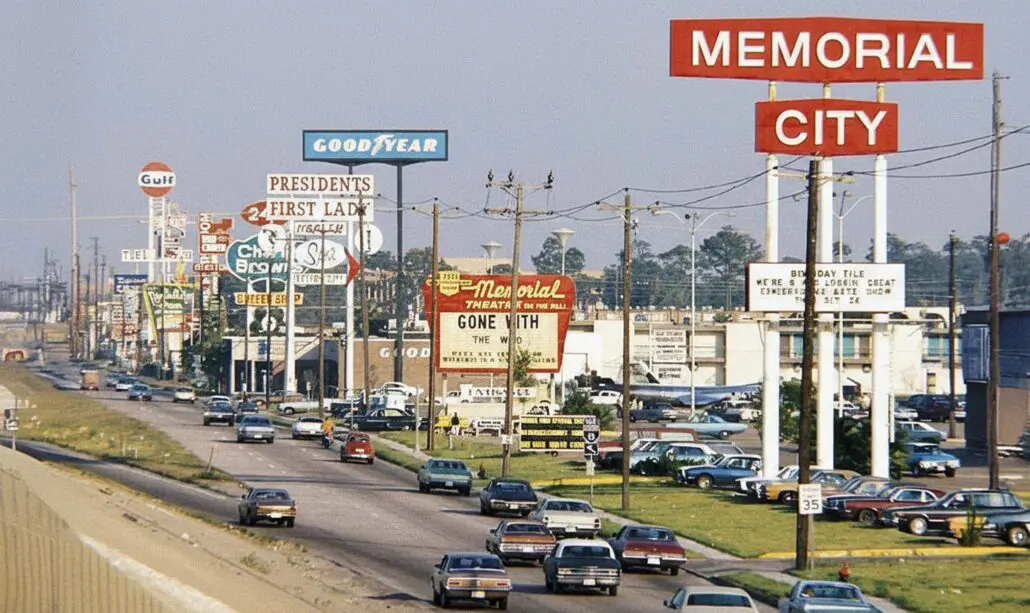Remember when the mall was the place to be? For many Houstonians, it was the center of social life. It was where you met friends, saw movies, and spent Saturdays browsing the latest fashion. The story of Houston’s growth is deeply connected to the story of its shopping malls. From the revolutionary arrival of air-conditioned comfort to the modern, open-air lifestyle districts of today, these centers have shaped our city. This is the history of Malls in Houston. We will look back at the trailblazers. We will celebrate the icons. And we will see how they have evolved to remain a vital part of our lives.
Houston’s First Air-Conditioned Mall
In the mid-20th century, Houston was booming. Suburbs were expanding rapidly. This created a need for new kinds of retail centers. In 1961, a groundbreaking development opened that would change Houston shopping forever: Sharpstown Center (still known as Houston Sharpstown Mall).
Developed by Frank Sharp, it was Houston’s first fully enclosed, air-conditioned shopping mall. This was a game-changer in the city’s hot and humid climate. It offered a cool and comfortable escape. The mall was an instant success. It was anchored by beloved Houston department stores like Foley’s and Montgomery Ward. For decades, Sharpstown was a thriving community hub. However, as the city grew, it faced new competition. The area’s demographics shifted. The mall eventually declined before being successfully rebranded as
PlazAmericas, which today serves the vibrant Hispanic community in the area.
Arrival of The Galleria Mall
If Sharpstown was the beginning, The Galleria was the revolution. When developer Gerald D. Hines opened its doors on November 16, 1970, he didn’t just build another mall. He imported a European concept and created an American icon.
Inspired by Milan’s Galleria Vittorio Emanuele II, The Galleria was a visionary project. It was the first mall in the United States to combine retail with a hotel, office towers, and its famous ice-skating rink, all from day one. This “mixed-use” model was groundbreaking. It transformed the mall from a simple shopping trip into a full-day destination. The Galleria’s impact was immediate. It shifted Houston’s retail center of gravity from Downtown to the Uptown area, effectively creating a “second downtown” along Post Oak Boulevard. With its unmatched collection of luxury stores like Neiman Marcus, Chanel, and Gucci, it cemented its status as the best mall in Texas for high-fashion shopping.
The Golden Age of Malls
The success of The Galleria fueled a suburban mall boom. Through the late 1970s and 1980s, new indoor malls opened to serve Houston’s rapidly growing communities. These centers became the social and retail hearts of their neighborhoods.
- Baybrook Mall opened in 1978, serving the Clear Lake and Bay Area communities.
- Willowbrook Mall followed in 1981, becoming the go-to destination for Northwest Houston.
- Deerbrook Mall opened in 1984, anchoring the retail scene in the Humble and Kingwood area.
These malls were the backdrop for a generation of Houstonians’ lives. They were the places for back-to-school shopping, first dates at the movie theater, and weekend afternoons spent in the food court.

The Stories of Lost Houston Malls
Not all malls stood the test of time. As Houston continued to evolve, some once-thriving centers began to decline. Their stories are a key part of the history of Houston malls.
Greenspoint Mall, which opened in 1976, was once the largest mall in the area. However, it suffered from economic downturns and a persistent, negative reputation for crime that earned it the nickname “Gunspoint Mall”. After a long decline, its interior officially closed in 2024. Similarly, Northwest Mall, which opened in 1968, was a popular destination for decades. It eventually struggled with high vacancy rates and closed its interior in 2017. The site is now the preferred location for the Houston station of the planned high-speed train to Dallas.
The Modern Reinvention: The Rise of the Lifestyle Centers
By the 2000s, shoppers’ tastes had changed. People wanted more than just an enclosed space. They wanted beautiful outdoor areas, great restaurants, and unique entertainment. This led to the rise of the “lifestyle center.”
CITYCENTRE is the ultimate example of this modern trend. Built on the site of the former Town & Country Mall, it is a vibrant, walkable district. It blends upscale shops with amazing restaurants, a luxury movie theater, and a central plaza that hosts live music. In the same vein,
River Oaks District offers a European-style streetscape with an exclusive focus on the world’s top luxury brands. These destinations prove that modern shopping is about the total experience.
What’s Next? The Future of Houston Malls
The evolution continues. Houston’s most successful malls are adapting to stay relevant. Memorial City Mall is undergoing a massive redevelopment. It is transforming its former Sears site into an open-air “town square” with new shops, restaurants, and green spaces. Likewise, First Colony Mall is enhancing its outdoor areas with a new play area and more community event spaces. This “hybrid” model, which combines the comfort of an indoor mall with the appeal of an outdoor lifestyle center, is the clear future of shopping in Houston.
The history of malls in Houston is a story of constant change. From the air-conditioned pioneers of the 1960s to the luxury icons and the modern lifestyle hubs, these centers have always reflected the spirit of our dynamic city. They are no longer just places to shop. They are places to gather, dine, and be entertained.
To explore all of Houston’s current shopping destinations, from the biggest indoor malls to the charming outdoor centers, be sure to check out our interactive map of Malls in Houston.




